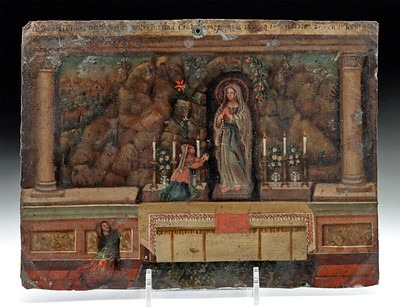8th C. Indian Pala Stone Panel of Tara Bodhisattva
Lot 71
About Seller
Artemis Gallery
686 S Taylor Ave, Ste 106
Louisville, CO 80027
United States
Selling antiquities, ancient and ethnographic art online since 1993, Artemis Gallery specializes in Classical Antiquities (Egyptian, Greek, Roman, Near Eastern), Asian, Pre-Columbian, African / Tribal / Oceanographic art. Our extensive inventory includes pottery, stone, metal, wood, glass and textil...Read more
Estimate:
$2,400 - $3,600
Absentee vs Live bid
Two ways to bid:
- Leave a max absentee bid and the platform will bid on your behalf up to your maximum bid during the live auction.
- Bid live during the auction and your bids will be submitted real-time to the auctioneer.
Bid Increments
| Price | Bid Increment |
|---|---|
| $0 | $25 |
| $300 | $50 |
| $1,000 | $100 |
| $2,000 | $250 |
| $5,000 | $500 |
| $10,000 | $1,000 |
| $20,000 | $2,500 |
| $50,000 | $5,000 |
| $100,000 | $10,000 |
| $200,000 | $20,000 |
About Auction
By Artemis Gallery
Jun 15, 2023
Set Reminder
2023-06-15 10:00:00
2023-06-15 10:00:00
America/New_York
Bidsquare
Bidsquare : VARIETY Ancient, Ethno, Native American, Fine Art
https://www.bidsquare.com/auctions/artemis-gallery/variety-ancient-ethno-native-american-fine-art-12990
Antiquities, ethnographic, native american and fine art from cultures encompassing the globe. Artemis Gallery info@artemisgallery.com
Antiquities, ethnographic, native american and fine art from cultures encompassing the globe. Artemis Gallery info@artemisgallery.com
- Lot Description
South Asia, India, region of Bengal, Pala Empire, ca. 8th to 12th centuries CE. A graceful stone sculpture depicting the goddess Tara - literally "savioress" - in high relief. Here she is shown bare-chested and holding a flowering lotus stem in one hand, while the other hand is open displaying the varada-mudra - the gesture of granting wishes. She is set against an elaborate backplate, which frames her figure and defines her status. A throne back with a dedicatory inscription is positioned behind her, as a large nimbus surrounds her head. Her voluptuous body is decorated with lavish adornments, such as armbands, necklaces, huge earrings, and a tiara - all of which reaffirm her elevated status. Size: 6.6" W x 11.3" H (16.8 cm x 28.7 cm); 12" H (30.5 cm) on included custom stand.
Tara was a hugely popular Vajrayana deity with the rise of Tantra in 8th century Pala, a combination of "Mother of all Buddhas" and the Indian concept of a mother goddess. During the Pala dynasty, the kingdom was one of the only places in India where Buddhism was practiced; as a result, it became an enclave of Buddhist art, with Buddhist monks, students, and pilgrims journeying from across Asia to see holy sites, monasteries, and universities. When they returned home, the Pala artistic style journeyed with them, giving it great influence in art throughout the Buddhist world. See a similarly styled figure of Tara from the Pala period in bronze at the Metropolitan Museum of Art.
Provenance: private Stillwater, Minnesota, USA collection; ex-Artemis Gallery, Louisville, Colorado, USA, March 15, 2017, lot 48; ex-prominent Los Angeles County, California, USA collection, acquired prior to 2000
All items legal to buy/sell under U.S. Statute covering cultural patrimony Code 2600, CHAPTER 14, and are guaranteed to be as described or your money back.
A Certificate of Authenticity will accompany all winning bids.
We ship worldwide and handle all shipping in-house for your convenience.
#179251Fragment of a larger piece with chipping to peripheries and proper right forearm. Some expected surface wear with nicks and abrasions as shown, but otherwise excellent with nice preservation of detail.Condition
- Shipping Info
-
All shipping is handled in-house for your convenience. Your invoice from Artemis Gallery will include shipping calculation instructions. If in doubt, please inquire BEFORE bidding for estimated shipping costs for individual items.
-
- Buyer's Premium



 EUR
EUR CAD
CAD AUD
AUD GBP
GBP MXN
MXN HKD
HKD CNY
CNY MYR
MYR SEK
SEK SGD
SGD CHF
CHF THB
THB













